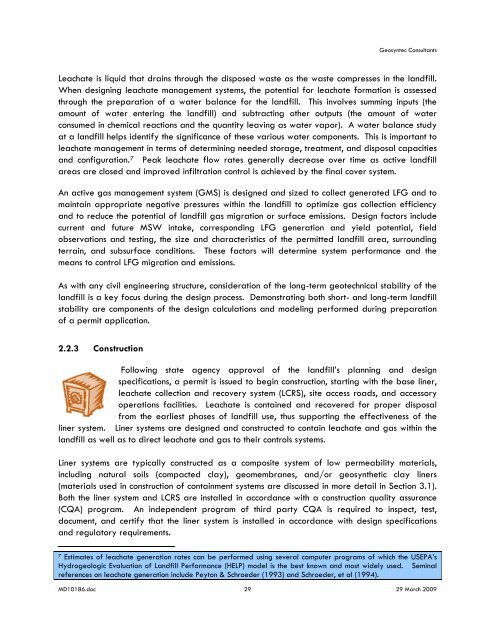AREA A/B ENGINEERING REPORT - Waste Management
AREA A/B ENGINEERING REPORT - Waste Management
AREA A/B ENGINEERING REPORT - Waste Management
You also want an ePaper? Increase the reach of your titles
YUMPU automatically turns print PDFs into web optimized ePapers that Google loves.
Geosyntec Consultants<br />
Leachate is liquid that drains through the disposed waste as the waste compresses in the landfill.<br />
When designing leachate management systems, the potential for leachate formation is assessed<br />
through the preparation of a water balance for the landfill. This involves summing inputs (the<br />
amount of water entering the landfill) and subtracting other outputs (the amount of water<br />
consumed in chemical reactions and the quantity leaving as water vapor). A water balance study<br />
at a landfill helps identify the significance of these various water components. This is important to<br />
leachate management in terms of determining needed storage, treatment, and disposal capacities<br />
and configuration. 7 Peak leachate flow rates generally decrease over time as active landfill<br />
areas are closed and improved infiltration control is achieved by the final cover system.<br />
An active gas management system (GMS) is designed and sized to collect generated LFG and to<br />
maintain appropriate negative pressures within the landfill to optimize gas collection efficiency<br />
and to reduce the potential of landfill gas migration or surface emissions. Design factors include<br />
current and future MSW intake, corresponding LFG generation and yield potential, field<br />
observations and testing, the size and characteristics of the permitted landfill area, surrounding<br />
terrain, and subsurface conditions. These factors will determine system performance and the<br />
means to control LFG migration and emissions.<br />
As with any civil engineering structure, consideration of the long-term geotechnical stability of the<br />
landfill is a key focus during the design process. Demonstrating both short- and long-term landfill<br />
stability are components of the design calculations and modeling performed during preparation<br />
of a permit application.<br />
2.2.3 Construction<br />
Following state agency approval of the landfill’s planning and design<br />
specifications, a permit is issued to begin construction, starting with the base liner,<br />
leachate collection and recovery system (LCRS), site access roads, and accessory<br />
operations facilities. Leachate is contained and recovered for proper disposal<br />
from the earliest phases of landfill use, thus supporting the effectiveness of the<br />
liner system. Liner systems are designed and constructed to contain leachate and gas within the<br />
landfill as well as to direct leachate and gas to their controls systems.<br />
Liner systems are typically constructed as a composite system of low permeability materials,<br />
including natural soils (compacted clay), geomembranes, and/or geosynthetic clay liners<br />
(materials used in construction of containment systems are discussed in more detail in Section 3.1).<br />
Both the liner system and LCRS are installed in accordance with a construction quality assurance<br />
(CQA) program. An independent program of third party CQA is required to inspect, test,<br />
document, and certify that the liner system is installed in accordance with design specifications<br />
and regulatory requirements.<br />
7 Estimates of leachate generation rates can be performed using several computer programs of which the USEPA’s<br />
Hydrogeologic Evaluation of Landfill Performance (HELP) model is the best known and most widely used. Seminal<br />
references on leachate generation include Peyton & Schroeder (1993) and Schroeder, et al (1994).<br />
MD10186.doc 29 29 March 2009

















